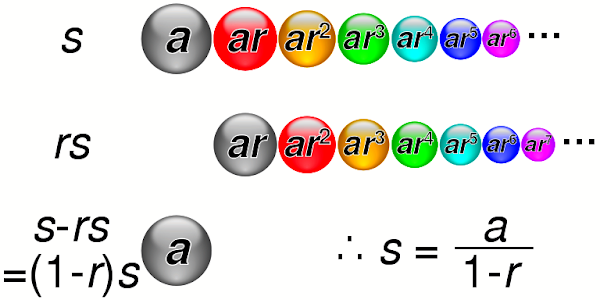Geometric Progression တစ်ခု၏ $n$ terms အထိ ပေါင်းလဒ်ကို
$S_n= \dfrac{a(1-r^n)}{1-r}$
ဟုသိရှိခဲ့ပြီး ဖြစ်သည်။ ညီမျှခြင်းကို အောက်ပါအတိုင်း အကျယ်ဖြန့်ကြည့်ပါမည်။
$\begin{aligned} S_n&= \dfrac{a(1-r^n)}{1-r}\\\\ &= \dfrac{a-ar^n}{1-r}\\\\ &= \dfrac{a}{1-r}-\dfrac{ar^n}{1-r}\\\\ \end{aligned}$
Case I.
$|r|>1 \text{ i.e., } r<-1 \text{ or } r>1,$
$(\text{ e.g., } a=2, r=2)$
|
$\begin{array}{|r|r|} \hline n\hspace{.2cm} & S_n\hspace{4cm} \\ \hline 1 & 2 \\ \hline 5 & 62 \\ \hline 10 & 2046 \\ \hline 50 & 2251799813685246 \\ \hline 100 & 2535301200456458802993406410750 \\ \hline \end{array}$ |
|---|
$n\rightarrow \infty$ ($n$ သည် အနန္တပမာဏသို့ ချဉ်းကပ်သွားသည်)
$S_n\rightarrow \infty$ ($S_n$ သည်လည်း အနန္တပမာဏသို့ ချဉ်းကပ်သွားသည်)
ထို့ကြောင့် အနန္တကိန်းလုံးအရေအတွက်ထိ ပေါင်းလဒ်ကို ရှာယူရန် မဖြစ်နိုင်တော့ပါ။
ထိုအခြေအနေကို divergent condition ဟုခေါ်သည်။ Divergent Condition တွင် Infinite Sum (အနန္တကိန်းလုံးအရေအတွက်ထိ ပေါင်းလဒ်) ကို ရှာ၍မရနိုင်ပါ။
Case II.
$|r|=1 \text{ i.e., } r=\pm 1$
အကယ်၍ $r=1$ ဖြစ်လျှင်
$S_n = a + a + a + \dots$ to $n$ terms = $na$
ထိုအခါ $n$ ၏ တန်ဖိုးကြီးလာသည်နှင့် အမျှ $S_n$ ၏ ပမာဏ (magnitude) သည်လည်း ကြီးလာပါဦးမည်။
ထို့ကြောင့် အနန္တကိန်းလုံးအရေအတွက်ထိ ပေါင်းလဒ်ကို ရှာယူရန် မဖြစ်နိုင်တော့ပါ။
အကယ်၍ $r=-1$ ဖြစ်လျှင်
$S_n = a - a + a -a + a - \dots$ to $n$ terms = $a \text { if } n \text { is odd}$
$S_n = a - a + a -a + a - \dots$ to $n$ terms = $0 \text { if } n \text { is even}$
ထို့ကြောင့် အနန္တကိန်းလုံးအရေအတွက်ထိ ပေါင်းလဒ်ကို ရှာယူရန် မလိုတော့ပါ။
Case III.
$|r|<1 \text{ i.e., } -1< r < 1 $
$ (\text{ e.g., } a=2, r=\dfrac{1}{2})$
$\begin{array}{|r|l|r|} \hline n\hspace{.2cm} & \hspace{1.5cm}r^n & S_n\hspace{2.5cm} \\ \hline 1 & 0.5 & 2 \\ \hline 2 & 0.25 & 3 \\ \hline 3 & 0.125 & 3.5 \\ \hline 4 & 0.0525 & 3.75 \\ \hline 5 & 0.03125 & 3.875 \\ \hline 10 & 0.0009765625 & 3.9960937500000000000 \\ \hline 50 & 8.88\times 10^{-16}\approx 0 & 3.9999999999999964473 \\ \hline 100 & 7.88\times 10^{-31}\approx 0 & 4.0000000000000000000 \\ \hline 1000 & 9.33\times 10^{-32}\approx 0 & 4.0000000000000000000 \\ \hline \end{array}$ |
|---|
$|r|< 1$ အတွက် $n\rightarrow \infty$ ဖြစ်သည့်အခါ $S_n$ သည် တန်ဖိုးတစ်ခုတွင် မပြောင်းမလဲ တည်ရှိနေသည်။ အဆိုပါတန်ဖိုးမှာ limit of $S_n$ as $n$ approaches $\infty$ ပင် ဖြစ်သည်။
Exercises
- Determine whether the sum to infinity for each of the following geometric
progression exist and find the sum to infinity where they exist.
$\begin{aligned} &\\ \text{(a)} &\ 3,0.3,0.03, \ldots \\\\ \text{(b)} &\ \dfrac{1}{2}, \dfrac{2}{3}, \dfrac{8}{7}, \dfrac{32}{27}, \ldots \\\\ \text{(c)} &\ \dfrac{7}{2}, 3, \dfrac{18}{7}, \dfrac{108}{49}, \ldots\\\\ \end{aligned}$
- Find the sum to infinity of the following geometric series.
$\begin{aligned} &\\ \text{(a)} &\ 2+\dfrac{4}{3}+\dfrac{8}{9}+\ldots\\\\ \text{(b)} &\ 2+\dfrac{1}{2}+\dfrac{1}{8}+\dfrac{1}{32} \ldots\\\\ \text{(c)} &\ 3-\dfrac{2}{3}+\dfrac{4}{27}+\ldots\\\\ \text{(d)} &\ 81-27+9-3+\ldots\\\\ \end{aligned}$
- The $3^{\text {rd }}$ and $6^{\text {th }}$ term of a geometric progression are $9$ and
$2 \dfrac{2}{3}$ respectively. Calculate the common ratio, the first term and the sum to
infinity of the progression.
- The sum of an infinite geometric progression is $12$ and its first term is $3$ .
Fin the first four terms of the G.P.
- In a G.P. the ratio of the sum of the first three terms to the sum to infinity is
$19: 27$. Find the common ratio.
- The second term of a G.P. is $2$ and its sum to infinity is $9$ .
Find the sum of the first $4$ terms of the two possible geometric progressions.
- The sum of the first 3 terms of a G.P. is $27$ and the sum of the fourth, fifth and
sixth terms is $-1$. Find the common ratio and the sum to infinity of the G.P.
- Given that $x+18, x+4$ and $x-8$ are the first three terms of a G.P.,
find the value of $x$. Hence find
(a) the common ratio
(b) the fifth term
(c) the sum to infinity.
- Given that $2 x-14, x-4$ and $\dfrac{1}{2} x$ are successive terms of a sequence.
(a) find the value of $x$ when the sequence is (i) an A.P. (ii) a G.P.
(b) If $2 x-14$ is the $3^{\text {rd }}$ term of a G.P. with infinite terms, find
(i) the common ratio
(ii) the sum to infinity.
- A G.P. has a first term $18$ and a sum to infinity of $30$.
Each of the terms in the progression is squared to form a new G.P.
Find the sum to infinity of the new progression.
- The first term of a G.P is $a$ and the common ratio is $r$.
Given that $a+96 r=0$ and that the sum to infinity is $32$ , find the $8^{\text {th }}$ term.
- An infinite geometric series has a finite sum of $256$ .
The sum of the first $3$ terms is $224$. What is the value of the $3^{\text {rd }}$ term?
- In a G.P., whose first term is positive, the sum of the first and third terms
$\dfrac{13}{9}$ and the product of second and fourth terms is
$\dfrac{16}{81}$. Find the common ratio and the sum to infinity.
- In a G.P. the sum of the first term and the fourth term is $144$ ,
and the first term exceeds the seventh term by $126$ .
Find the first term, the common ratio and the sum to infinity of the G.P.
- The first term of a G.P. is $3$ and the common ratio is $\dfrac{2}{5}$.
Find the sum to infinity, and the least value of $n$ for which the sum to $n$
terms differ from the sum to infinity by less than $0.04$.
စာဖတ်သူ၏ အမြင်ကို လေးစားစွာစောင့်မျှော်လျက်!

